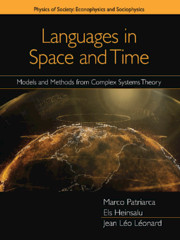Chapter 4 - Historical Glottometry
Published online by Cambridge University Press: 04 June 2020
Summary
Background
The family tree model (Stammbaumtheorie) is a major approachto the interpretation and visualization of the (historical) relationshipsamong languages. It provides a simple and clear picture of the emergence ofa language family, starting from the single original community speaking theprotolanguage, then gradually splitting up into more and moresubcommunities, finally turning into the observed group of languages.
One of the main limitations of the tree model of language evolution is theunderlying assumption that the protolanguage developsindependently in each branched subcommunity. Such anidealized situation rarely occurs; usually, innovations are born in onecommunity and spread to other adjacent communities. The diffusion ofinnovations across a dialect continuum can result in a patchwork ofintersecting innovations, a scenario that does not fit into the simplepattern of a tree model and a cladistic approach. To overcome thedifficulties of the tree model, the wave theory wasproposed and developed in the framework of historical linguistics (see deSaussure [1915] and Bloomfield [1926]). The wave theory allows thedescription of languages as entities continuously evolving while interactingwith each other. To distinguish between these very different situationsdescribed by a tree model on one hand and wave theory on the other hand, theterm language family was proposed in a sense similar to thegenetic family, that is, as isolated subgroups (Ross, 1988). The termlinkage was also introduced to represent a languageinside an interactive language network (Schmidt, 1872), in which, inprinciple, all languages interact with each other.
Wave Theory
In this section, we focus on historical glottometry, whichwas inspired by the wave theory and introduced in the works of Siva Kalyanand Alexandre François on the languages of Vanuatu, an island nationin the Australian continent (François, 2012). The basic idea of thewave model is the evolution and spreading of innovations, whichFrançois defined as changes shared by all thelanguages of modern speakers (François, 2014). The presence orabsence of innovations creates geographical borders known asisoglosses which define the areas corresponding tolanguages, which, in the spirit of wave theory, usually overlap with eachother.
- Type
- Chapter
- Information
- Languages in Space and TimeModels and Methods from Complex Systems Theory, pp. 79 - 94Publisher: Cambridge University PressPrint publication year: 2020

